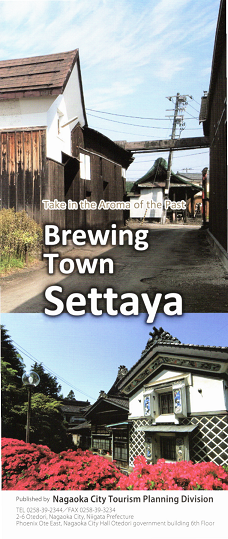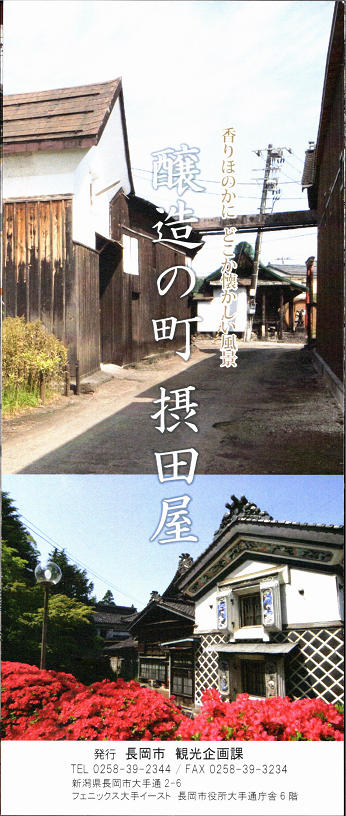The citizens group that want conservation for the old buildings and garden

About Settaya town, Nagaoka city, Niigata
0. Sample route1. Location and history
2. Shopping street and "Gangi"
3. Folk religion in Settaya
4. Nature of the Ohta-Gawa River and its upstream region
5. Benefit of the Ohta-Gawa River
0. Sample route
Here are three basic information,a walking route and access map for your assistance,
a short route guide in Settaya town, and
a detail route guide in Settaya town about two hours-walking.
1. Location and history
Settaya town is located at about 3km to the south from the center of Nagaoka city, Niigata. Settaya is an integrated region of Japanese Sake, soy sauce, and soy paste industry. More than six factories of fermentation industry have been prosperous during several hundred years. Famous sake brewery "Yoshinogawa" is here, and other famous old brand "Kina-Saffrom liqueur" is located on the oblique opposite. Saffrom liqueur is an alcoholic drinks with medical properties. It is said that the saffron liquor had halved the market and popularity with healthy liqueur "Yomeishu", keeping still attractive brand in Japan. Leaflet (Simplified Chinese is here.) |
 |
 |
| English Leaflet MAP,etc. PDF |
Japanese Leaflet MAP.etc.PDF |
Traditional Chinese MAP,etc.PDF |
2. Shopping street and "Gangi"
It is characteristic that all storefronts of the shopkeeper-houses are faced to shopping streets of the town, and common roofs "Gangi" are built among a lot of houses.They were devised in the early Edo period among the northern part of Japan, to live in long winter season with heavy snow fall. In Miyauchi town, it is about 500 meters from the crossing in front of the station to the next Brock crossing near the Settaya-brewering industry zone.
3. Folk religion in Settaya, Nagaoka
(1) Jizo-BosatsuInitially this guardian deity of children (in Japanese, Jizo-Bosatsu) generally took form of ascetic (self-disciplined) practices monks, but it became an image of a child before long. Then it finally becomes the guardian deity of children that has been loved as not only children but also all the peoples bothered with various suffering. They usually stand on waysides or branch points of village entrances or mountain paths.
(2) Takekoma Inari Jinjya (shrine)
Inari Jinjya is said to be a tutelary shrine guarding the local people. It is admired as the gods of harvest and industry. A pair of foxes, thought as messengers of the gods, stands at the gate of shrines.
(3) Jyuuni Jinjya in Magari-Aramachi
Jyuuni Jinjya is a shrine dedicating mountains god called Jyuuni (twelve). Number twelve means a lot of number. Jyuuni Jinjya is thought to pray faith of natural phenomena. There are many Jyuuni Jinjyas in Japan.
(4) Usual method of praying in Jinja
-1) Passing through the sacred arch at the shrine. [seikred]
-2) Wash our hands to purify ourselves before making a prayer at the shrine before making a prayer. First of all, Wash both of your hands with a ladleful of water, and wash out your mouth too. But please do not put your mouth to a ladle. Lastly, wash the handle with remaining water and then put the ladle back.
-3) Give a small offering (Optional)
-4) Ring the bell to notify the god of your visiting
-5) First bow lightly, and bow twice, Clap your hands twice, and then put your hands together quietly and pray in silence sincere heart, and bow lightly again before you leave.
They are generally supposed to follow the same steps of bowing twice, clapping hands twice, and bowing once, but following the instructions of the each Shinto priest is more important.
4. Nature of the Ohta-Gawa River and its upstream region
(1) Settaya town is near a middle basin of a river, called the Ohta-Gawa River. The river joins to the Shinano-Gawa River about five kilometers to the north. A channel flows under the Ohta-Gawa River bed with the principle of siphon like 3D intersection. The channel was developed about four hundred years ago by volunteer of a farmer, and even now, it has been utilizing for main part of rice fields in Nagaoka area.(2) Birds found in riverside of the Ohta-Gawa River More than one couple of pheasant have settled in the riverside. A male of pheasant has beautiful colored body, in particular red in the face and bluish-purple to green in the neck to breast. Sometimes large heron is found flying on the river. White body and black wings of wagtail is popular near the river.
(3) Abundant water by melted snow and scenery of the Higashi-Yama Hills A central portion of the Higashi-Yama Hills can be seen from the causeway of the Ohta-Gawa River. The rightmost mountain is called the Kanakura-Yama. Several folded mountains left neighbor the Kanakura-Yama is called the Nanban-Yama. Origin, source of the the Ohta-Gawa River is in Takenokouchi village, the back left of that lower than the ambient V-pattern area between the Kanakura-Yama and the Nanban-Yama. There are several comfortable hiking trails and hot springs in those area.
One of them, I recommend, is a route starting from near here to the Takenokouchi via the Nanban-Yama. It take about four or five hours trails at a slow speed, not so steep way. The other hiking trail in the Kanakura-Yama is excellent too. Hot springs Yomogihira Hot springs are available after a day hiking trail.
Very large rocks are found in the upper strem area. The height of them sometimes overtakes two meters. This is usually a small river, however after destructive storm, it can wash away such large rocks. In the season of snow melting away, its flow has plenty of water.
5. Benefit of the Ohta-Gawa River
They said that "Mid-winter season is suitable for the Sake-production". From winter to early spring, the Ohta-Gawa River has much quantity of water by melting snow, so this area should have been suitable for the shipment of new Sake in early spring.Actually, flow quantity of the Ohta-Gawa River in this area is considered to be the beat condition, not too high speed, not too slow speed. This is the fact that sake production had started in old age, before the Edo period. After Meiji era started, Nagaoka area was flourished by oil production and mechanical industry associated with the production. This flourishing of Nagaoka has been further driving forward strongly on the various industries including the Settaya brewing industry. ( Kimono fabric and marchants, Japanese sake industry, et cetera)
〇 Map and additional information (PDF file)
Settaya Town map
Settaya additional_info_E001
